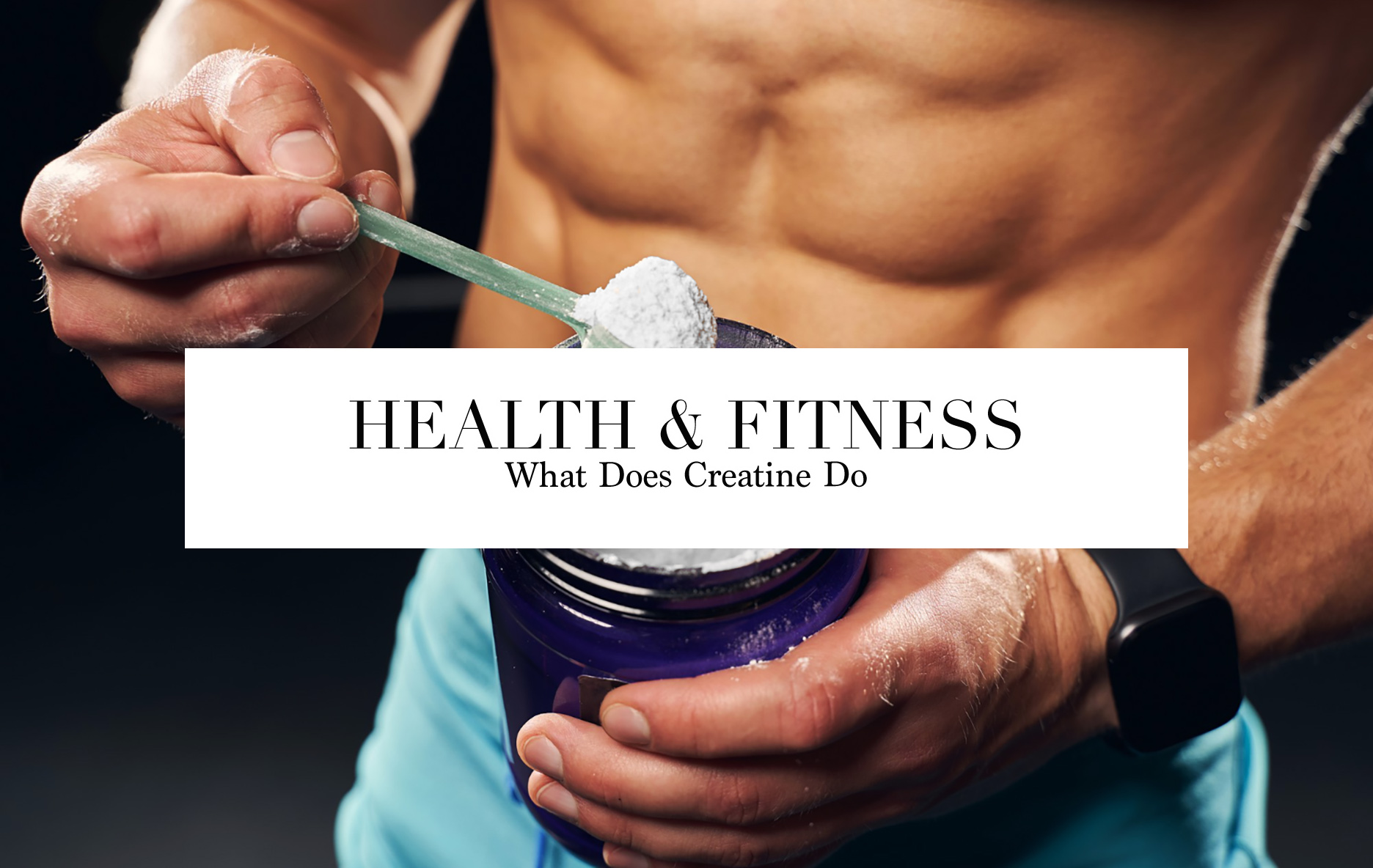Creatine, a widely used dietary supplement, has garnered significant attention in the fitness and athletic for its purported performance-enhancing effects. But what does creatine do? Beyond its association with strength gains and muscle building, the mechanisms and potential benefits of creatine supplementation extend far deeper, backed by scientific research. In this article, we delve into the roles of creatine in the body, exploring its impact on muscle function, brain health, and beyond, while also examining the different types of creatine supplements available.
Understanding Creatine:
Creatine is a naturally occurring compound found primarily in red meat and fish, synthesized in the liver, kidneys, and pancreas from amino acids such as glycine, arginine, and methionine. It plays a crucial role in the production of adenosine triphosphate (ATP), the primary energy currency of cells. ATP powers various cellular processes, including muscle contraction, making it indispensable for physical performance.
Enhancing Physical Performance:
One of the most well-established effects of creatine supplementation is its ability to enhance physical performance, particularly during high-intensity, short-duration activities. Numerous studies have demonstrated that creatine supplementation can increase muscle phosphocreatine stores, leading to improved ATP regeneration and subsequently enhancing strength and power output (Buford et al., 2007).
In a meta-analysis by Kreider et al. (2017), it was found that creatine supplementation significantly increased strength and lean body mass in resistance-trained individuals compared to a placebo. These findings underscore the efficacy of creatine as an ergogenic aid for athletes and fitness enthusiasts alike.
Muscle Growth and Hypertrophy:
Beyond its immediate performance-enhancing effects, creatine also plays a crucial role in muscle growth and hypertrophy. By promoting cell volumization and increasing water content within muscle cells, creatine supplementation creates an optimal environment for protein synthesis and muscle repair (Rae et al., 2003).
Research by Volek et al. (1999) suggests that creatine supplementation can augment muscle fiber size and contribute to long-term gains in muscle mass, particularly when combined with resistance training. These findings have significant implications for athletes seeking to maximize their muscle-building potential.
Cognitive Enhancement:
While creatine is often associated with physical performance, emerging research highlights its potential cognitive benefits. The brain, like muscle tissue, relies heavily on ATP for energy production, and creatine supplementation may support cognitive function by enhancing ATP availability in the brain (Rae et al., 2003).
Studies have shown that creatine supplementation can improve cognitive performance, particularly in tasks requiring short-term memory and cognitive processing under stress (Rae et al., 2003). Moreover, research by McMorris et al. (2006) suggests that creatine supplementation may mitigate the cognitive decline associated with sleep deprivation, further highlighting its potential neuroprotective effects.
Health Benefits Beyond Performance:
In addition to its roles in physical performance and cognitive function, creatine supplementation has been investigated for its potential therapeutic benefits in various health conditions. Research suggests that creatine may have antioxidant properties, offering protection against oxidative stress and inflammation (Bender et al., 2008).
Furthermore, preliminary studies indicate that creatine supplementation may hold promise in the management of neurological disorders such as Parkinson’s disease and Huntington’s disease, although further research is needed to elucidate its mechanisms and efficacy (Bender et al., 2008).
Different Types of Creatine Supplements:
Creatine supplements are available in various forms, each with its unique characteristics and potential benefits:
- Creatine Monohydrate:
Creatine monohydrate is the most extensively researched and commonly used form of creatine supplementation. It consists of creatine molecules bound to a water molecule, ensuring stability and solubility. Creatine monohydrate has been shown to be highly bioavailable and effective in increasing muscle creatine stores, making it the preferred choice for most individuals.
- Creatine Ethyl Ester:
Creatine ethyl ester is a modified form of creatine that has been esterified to enhance its absorption and bioavailability. Advocates claim that creatine ethyl ester may offer superior solubility and uptake compared to creatine monohydrate, leading to enhanced effectiveness. However, research supporting these claims is limited.
- Buffered Creatine (Kre-Alkalyn):
Buffered creatine, also known as Kre-Alkalyn, is creatine monohydrate that has been formulated with alkaline compounds to increase its pH level. Proponents of buffered creatine claim that this form offers greater stability and reduced conversion to creatinine, a waste product associated with creatine breakdown. However, scientific evidence supporting the superiority of buffered creatine over creatine monohydrate is limited.
- Creatine HCl (Creatine Hydrochloride):
Creatine hydrochloride is a form of creatine that has been chemically bonded with hydrochloric acid to enhance its solubility and absorption. Advocates suggest that creatine HCl may offer similar benefits to creatine monohydrate but with lower doses required due to its increased bioavailability. However, research comparing creatine HCl to creatine monohydrate is limited.
- Micronized Creatine:
Micronized creatine is creatine monohydrate that has undergone a micronization process to reduce particle size, thereby enhancing solubility and dispersibility in liquid. This form of creatine is often favored for its improved mixability and reduced risk of gastrointestinal discomfort compared to standard creatine monohydrate powder.
- Creatine Magnesium Chelate:
Creatine magnesium chelate is a form of creatine that has been bonded with magnesium ions to enhance absorption and bioavailability. While research on creatine magnesium chelate is limited compared to other forms, preliminary studies suggest that it may offer similar benefits to creatine monohydrate with the added advantage of magnesium supplementation.
Choosing the Right Form of Creatine:
With a plethora of creatine supplements available on the market, choosing the right form can be daunting. While each type of creatine may offer unique advantages in terms of solubility, stability, or absorption, the most critical factor is efficacy backed by scientific evidence.
Creatine monohydrate remains the gold standard for creatine supplementation, supported by decades of research demonstrating its safety, efficacy, and affordability. While alternative forms of creatine may offer theoretical advantages, such as enhanced bioavailability or reduced side effects, the evidence supporting their superiority over creatine monohydrate is limited.
Reference:
· Buford, T. W., Kreider, R. B., Stout, J. R., Greenwood, M., Campbell, B., Spano, M., … & Antonio, J. (2007). International Society of Sports Nutrition position stand: creatine supplementation and exercise. Journal of the International Society of Sports Nutrition, 4(1), 6. DOI: 10.1186/1550-2783-4-6
· Kreider, R. B., Kalman, D. S., Antonio, J., Ziegenfuss, T. N., Wildman, R., Collins, R., … & Lopez, H. L. (2017). International Society of Sports Nutrition position stand: safety and efficacy of creatine supplementation in exercise, sport, and medicine. Journal of the International Society of Sports Nutrition, 14(1), 18. DOI: 10.1186/s12970-017-0173-z
· Rae, C., Digney, A. L., McEwan, S. R., & Bates, T. C. (2003). Oral creatine monohydrate supplementation improves brain performance: a double–blind, placebo–controlled, cross–over trial. Proceedings of the Royal Society of London. Series B: Biological Sciences, 270(1529), 2147-2150. DOI: 10.1098/rspb.2003.2492
· Volek, J. S., Duncan, N. D., Mazzetti, S. A., Staron, R. S., Putukian, M., Gómez, A. L., … & Kraemer, W. J. (1999). Performance and muscle fiber adaptations to creatine supplementation and heavy resistance training. Medicine and science in sports and exercise, 31(8), 1147-1156. DOI: 10.1097/00005768-199908000-00011
· McMorris, T., Mielcarz, G., Harris, R. C., Swain, J. P., & Howard, A. (2006). Creatine supplementation and cognitive performance in elderly individuals. Aging, Neuropsychology, and Cognition, 13(3-4), 517-528. DOI: 10.1080/13825580600582905
· Bender, A., Koch, W., Elstner, M., Schombacher, Y., Bender, J., Moeschl, M., … & Klopstock, T. (2008). Creatine supplementation in Parkinson disease: a placebo-controlled randomized pilot trial. Neurology, 71(10), 715-723. DOI: 10.1212/01.wnl.0000312370.87665.bd
· Hultman, E., Söderlund, K., Timmons, J. A., Cederblad, G., & Greenhaff, P. L. (1996). Muscle creatine loading in men. Journal of Applied Physiology, 81(1), 232-237. DOI: 10.1152/jappl.1996.81.1.232
· Spillane, M., Schoch, R., Cooke, M., Harvey, T., Greenwood, M., Kreider, R., & Willoughby, D. S. (2009). The effects of creatine ethyl ester supplementation combined with heavy resistance training on body composition, muscle performance, and serum and muscle creatine levels. Journal of the International Society of Sports Nutrition, 6(1), 6. DOI: 10.1186/1550-2783-6-6
· Jäger, R., Harris, R. C., Purpura, M., & Francaux, M. (2011). Comparison of new forms of creatine in raising plasma creatine levels. Journal of the International Society of Sports Nutrition, 8(1), 1-17. DOI: 10.1186/1550-2783-8-17
· Giese, M. W., Lecher, C. S., & Kolb, N. (2018). The effects of creatine supplementation on muscular performance and body composition responses to short-term resistance training overreaching. European Journal of Sport Science, 18(1), 62-72. DOI: [10.1080/17461391.2017.139



